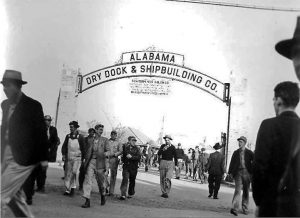The Alabama Dry Dock and Shipbuilding Company (ADDSCO) used asbestos in products, equipment, and machinery. Based in Mobile, Alabama, it was once one of the largest marine production facilities in the nation. Past workers at Alabama Dry Dock are at risk for mesothelioma and other asbestos illnesses.
Si a usted o a un ser querido le han diagnosticado mesotelioma, cáncer de pulmón relacionado con el asbesto o asbestosis, usted podría tener derecho a una compensación sustancial. Llene nuestro formulario para recibir nuestro boletín gratuito Financial Compensation Packet. Our packet is loaded with information on experienced mesothelioma attorneys in your area, how to file a claim for asbestos trust funds, how to get paid in 90 days, and more.


Paquete de compensación financiera GRATUITO
- Información sobre despachos de abogados que recuperarán su INDEMNIZACIÓN MÁS ALTA
- Aprenda cómo cobrar en 90 días
- Solicite su parte de $30 mil millones en fondos fiduciarios

Did Alabama Dry Dock Use Asbestos?
Alabama Dry Dock and Shipbuilding Company (ADDSCO) used asbestos in its operations for decades. This was typical in shipbuilding, where everything from boilers to pipes, electrical work, and insulation contained asbestos.
Like other shipyards, ADDSCO likely used asbestos in repairing and building ships from about the 1930s to the 1970s. Even after asbestos was no longer used in shipbuilding, it lingered in machinery, equipment, parts, and old ships.
Alabama Dry Dock and Shipbuilding Company History
ADDSCO was founded in 1916 by the president of Alabama Iron Works, D. R. Dunlap, along with his cousin, George H. Dunlap. The duo merged several small dry dock companies that offered berths for shipping, ship repair facilities, and other maritime-related activities.
- ADDSCO employed more than 4,000 people during World War I, ranging from welders, electricians, engineers, shipbuilders, and much more. When World War II began, the shipyard saw its greatest boom and focused almost exclusively on war efforts.
- The shipyard became so huge that by 1943, over 30,000 people worked there in various jobs. The need for workers was so great that women were trained and hired to work as welders.
- ADDSCO also employed Black men and women as President Roosevelt’s Fair Employment Practices Committee urged many workplaces to hire these workers. In 1943, racial tensions led to riots at the shipyard. The National Guard was called in to restore peace.
- ADDSCO became well-known for building 20 Liberty ships, as well as over 100 oil tankers, including the Arickaree, the largest ship ever constructed along the U.S. Gulf Coast. ADDSCO also created over 2,000 combat vessels before the end of World War II.
- After the war, many people were laid off as the shipyard slowed down its production of vessels. ADDSCO began focusing on repairing ships and various maritime projects. The yard closed in the 1970s because of labor unrest. It reopened later, and while it has changed hands many times, it never stopped operating.
- BAE Systems acquired the ADDSCO shipyard in 2010. BAE announced in 2018 that it would close the yard completely. Alabama Shipyard acquired it in 2019, and it has remained in operation.
Alabama Dry Dock Today
ADDSCO hit rough times beginning in the 1970s. It closed for a period, reopened, and changed ownership several times. Today, it is a part of Alabama Shipyard, the largest shipyard in Mobile.
Alabama Shipyard operates the yard for ship maintenance, repairs, and overhauls. It is a contractor for the Departments of Transportation and Defense.
During its heyday in the 1940s, ADDSCO employed thousands of people but had fewer than 12 by 2018. Under new ownership, the yard is thriving. In 2022, it began a major overhaul of the USNS Comfort, a Navy hospital ship, and other USNS ships. The current staff includes nearly 300 workers.
How Workers Were Harmed by Asbestos at ADDSCO
ADDSCO was not unusual in its use of asbestos. Asbestos was used heavily in shipbuilding for its insulating and fireproofing properties. Hundreds of asbestos components went into ships.
Anyone who worked at Alabama Dry Dock during the years of asbestos use was at risk of exposure. Workers handled products with asbestos that released fibers into the air.
Inhaled asbestos fibers lodge inside the body, causing damage to tissue and cells. In some people, this leads to cancers like mesothelioma or lung cancer many years later. Some exposed workers develop non-malignant respiratory illnesses, like asbestosis.
The workers at greatest risk for exposure handled asbestos directly or even had to cut into it to do their jobs:
- Instaladores de aislamiento
- Instaladores de tuberías
- trabajadores de calderas
- Machine operators
- Repair workers
- Mecánica
- Demolition or shipbreaking workers
AADSCO Workers File Asbestos Lawuits
Many of the workers and their families who were affected by asbestos use at AADSCO filed lawsuits. They sued the shipyard and companies that supplied it with asbestos.
Several employees filed a class-action lawsuit against the AADSCO in 1984. Most workers sued the manufacturing companies that provided the asbestos-containing products to the shipyard. Unfortunately for the workers, that lawsuit was dismissed. Other suits against asbestos companies were successful.
If you worked at AADSCO during the asbestos years, contact a mesothelioma or asbestos lawyer to find out how to seek compensation.
Additional Help and Resources
Si ha sufrido lesiones por mesotelioma, cáncer de pulmón relacionado con el asbesto o asbestosis, tenga en cuenta que es muy probable que tenga derecho a una indemnización considerable. No olvide completar nuestro formulario para obtener nuestro... Paquete de compensación financiera, lleno de información sobre los abogados con experiencia en asbesto y mesotelioma en su área. Si tiene preguntas o necesita ayuda adicional, contáctenos en 800-793-4540.

Pablo Danziger
Revisor y editorPaul Danziger creció en Houston, Texas, y se licenció en Derecho en la Facultad de Derecho de la Universidad Northwestern en Chicago. Durante más de 25 años, se ha dedicado a representar a víctimas de mesotelioma y a otras personas afectadas por la exposición al asbesto. Paul y su bufete han representado a miles de personas diagnosticadas con mesotelioma, asbestosis y cáncer de pulmón, obteniendo indemnizaciones significativas para los clientes lesionados. Cada cliente es fundamental para Paul y atenderá todas las llamadas de quienes deseen hablar con él. Paul y su bufete se encargan de casos de mesotelioma en todo Estados Unidos.
Conéctese con el abogado especializado en mesotelioma Paul Danziger
Referencias
- Encyclopedia of Alabama. (n.d.). Alabama Dry Dock and Shipbuilding Company.
Recuperado de: http://www.encyclopediaofalabama.org/article/h-1475 - Specker, L. (2022, April 29). Alabama Shipyard: On the Mobile Waterfront, a Sleeping Giant Has Awakened. AL.com.
Recuperado de: https://www.al.com/news/mobile/2022/04/alabama-shipyard-on-the-mobile-waterfront-a-sleeping-giant-has-awakened.html - Fuente de la foto:
Recuperado de: http://www.encyclopediaofalabama.org/article/h-1475
